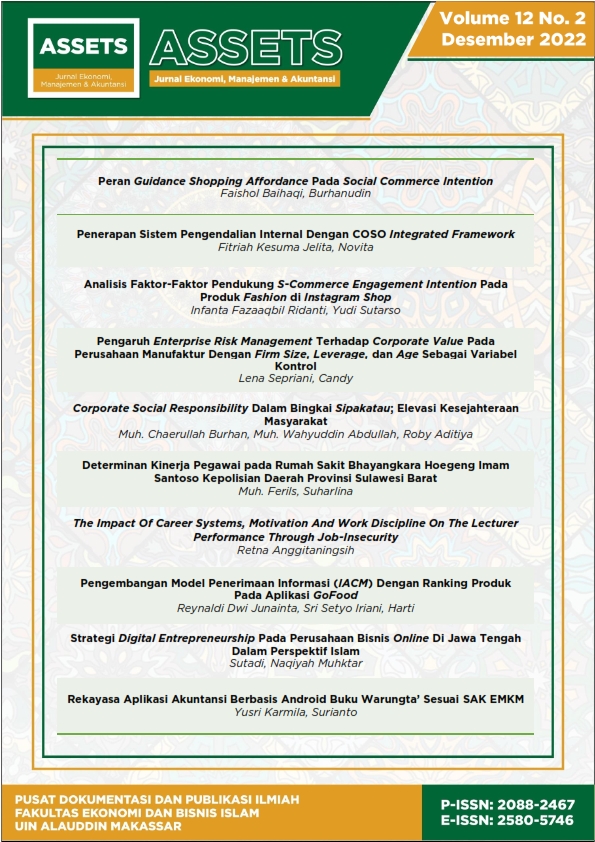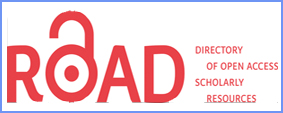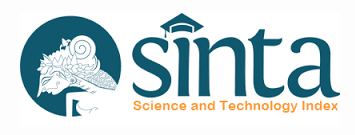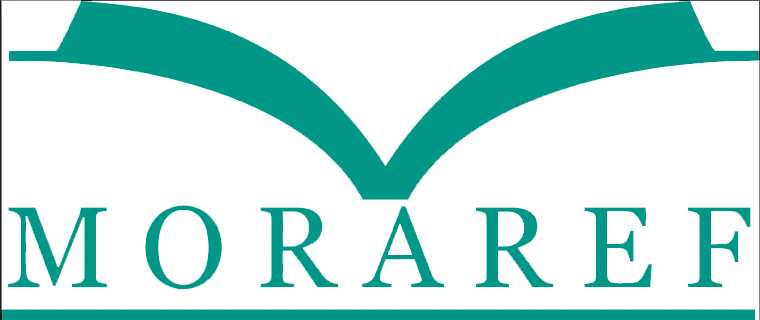PENGEMBANGAN MODEL PENERIMAAN INFORMASI (IACM) DENGAN RANKING PRODUK PADA APLIKASI GOFOOD
Abstrak
Penelitian ini bertujuan untuk mengidentifikasi serta menganalisis pengaruh ulasan dan bintang terhadap niat beli pengguna aplikasi GoFood. Hal ini didasarkan dari keputusan GoFood untuk menambahkan fitur ulasan pada aplikasinya. Penelitian ini mengembangkan model penerimaan informasi (IACM) dengan menambahkan ranking produk untuk menjawab tujuan penelitian. Model penerimaan informasi yang masih relatif baru dapat dikembangkan dan perlu diuji secara empiris. Metode penelitian ini menggunakan pendekatan kuantitatif dengan melakukan Analisa menggunakan AMOS. Penelitian ini menemukan bahwa ulasan dan bintang mempengaruhi niat beli pengguna aplikasi GoFood. Pengguna aplikasi cenderung mengabaikan kredibilitas ulasan pada platform terpercaya seperti GoFood. Bintang secara parsial tidak dapat mempengaruhi niat beli, namun dengan berinteraksi bersama ulasan melalui adopsi informasi, dapat mempengaruhi niat beli. Ulasan yang tersedia tidak begitu saja digunakan oleh konsumen dalam proses keputusan pembelian. Ulasan akan digunakan ketika konsumen menemukan produk yang tidak begitu dikenal. Ulasan dan bintang penting untuk meningkatkan niat beli konsumen terutama dalam situasi konsumen tidak mengenali produk yang dipesan.
Referensi
Bhat, N. Y., & Bhat, S. A. 2020. The influence of Electronic word of mouth (Ewom) on Consumers Purchase Intention: A review and analysis of the existing literature. IOSR J. Eng, 10, 27-36.
De Langhe, B., Fernbach, P. M., & Lichtenstein, D. R. 2016. Navigating by the stars: Investigating the actual and perceived validity of online user ratings. Journal of Consumer Research, 42(6), 817-833.
De Pelsmacker, P., Dens, N., & Kolomiiets, A. 2018. The impact of text valence, star rating and rated usefulness in online reviews. International Journal of Advertising, 37(3), 340-359.
Erkan, I., & Evans, C. 2016. The influence of eWOM in social media on consumers’ purchase intentions: An extended approach to information adoption. Computers in human behavior, 61, 47-55.
Filieri, R., & McLeay, F. 2014. E-WOM and accommodation: An analysis of the factors that influence travelers’ adoption of information from online reviews. Journal of travel research, 53(1), 44-57.
Fishbein, M., & Ajzen, I. 1977. Belief, attitude, intention, and behavior: An introduction to theory and research. Philosophy and Rhetoric, 10(2).
Goyette, I., Ricard, L., Bergeron, J., & Marticotte, F. 2010. e‐WOM Scale: word‐of‐mouth measurement scale for e‐services context. Canadian Journal of Administrative Sciences/Revue Canadienne des Sciences de l'Administration, 27(1), 5-23.
Hennig-Thurau, T., Gwinner, K. P., Walsh, G., & Gremler, D. D. 2004. Electronic word-of-mouth via consumer-opinion platforms: what motivates consumers to articulate themselves on the internet?. Journal of interactive marketing, 18(1), 38-52.
Hidayat, R., & Dahlan, D. 2019. Analysis of Online Customer Reviews Toward Interest Using Blibli as Online Marketplace in UPI Students.
Hidayat, W. F., Sanjaya, R., & Mustopa, A. 2020. Analisis Niat Pembelian Pada Instagram Online Shopping Menggunakan Information Acceptance Model (IACM). Bianglala Informatika, 8(1), 22-30.
Hu, N., Koh, N. S., & Reddy, S. K. 2014. Ratings lead you to the product, reviews help you clinch it? The mediating role of online review sentiments on product sales. Decision support systems, 57, 42-53.
Knoll, J. 2016. Advertising in social media: a review of empirical evidence. International journal of Advertising, 35(2), 266-300.
Kotler dan Keller. (2009). Manajemen Pemasaran. Jilid 1. Edisi ke 13. Jakarta: Erlangga.
Lackermair, G., Kailer, D., & Kanmaz, K. 2013. Importance of online product reviews from a consumer’s perspective. Advances in economics and business, 1(1), 1-5.
Ngarmwongnoi, C., Oliveira, J. S., AbedRabbo, M., & Mousavi, S. 2020. The implications of eWOM adoption on the customer journey. Journal of Consumer Marketing.
Park, T. 2020. How information acceptance model predicts customer loyalty? A study from perspective of eWOM information. The Bottom Line.
Rahman, M. S., & Mannan, M. 2018. Consumer online purchase behavior of local fashion clothing brands: Information adoption, e-WOM, online brand familiarity and online brand experience. Journal of Fashion Marketing and Management: An International Journal.
Richins, M. L., & Root-Shaffer, T. 1988. The role of evolvement and opinion leadership in consumer word-of-mouth: An implicit model made explicit. ACR North American Advances.
Santosa, F. V., & Wandebori, H. 2019. FACTORS AFFECTING USERS’PURCHASE INTENTION FROM EWOM REVIEWS IN VIRTUAL COMMUNITY: FEMALEDAILY. COM USING INFORMATION ACCEPTANCE MODEL (IACM). Social Capital, 6, H8.
Shin, S., Du, Q., Ma, Y., Fan, W., & Xiang, Z. 2021. Moderating effects of rating on text and helpfulness in online hotel reviews: an analytical approach. Journal of Hospitality Marketing & Management, 30(2), 159-177.
Sussman, S. W., & Siegal, W. S. 2003. Informational influence in organizations: An integrated approach to knowledge adoption. Information systems research, 14(1), 47-65.
Syafaruddin, Z. 2016. Pengaruh komunikasi electronicword of mouth terhadap kepercayaan (trust) dan niat beli (purchase intention) serta dampaknya pada keputusan pembelian (Survey pada konsumen online shopping zafertech. com). Jurnal Bisnis dan Manajemen, 3(1).
Tjongirin, R., Gianto, M., & Sihombing, S. 2020. Applying the information acceptance model to predict purchase intention in social media. Jurnal Manajemen dan Pemasaran Jasa, 13(2), 263-280.
Yeap, J. A., Ignatius, J., & Ramayah, T. 2014. Determining consumers’ most preferred E-WOM platform for movie reviews: A fuzzy analytic hierarchy process approach. Computers in Human Behavior, 31, 250-258.
Zhao, Y., Wang, L., Tang, H., & Zhang, Y. 2020. Electronic word-of-mouth and consumer purchase intentions in social e-commerce. Electronic Commerce Research and Applications, 41, 100980.
##submission.copyrightStatement##
##submission.license.cc.by-nc-sa4.footer##









